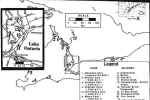|
1991.
M.Sc.,
173 pp.
SEDIMENTOLOGY OF THE QUEENSTON FORMATION, ORDOVICIAN, S.W. ONTARIO
Brogly,
P.
 The
detailed study of core from the Queenston Formation in Southern Ontario has
revealed a variety of sedimentary structures, trace fossils, bioturbation and
gypsum. Supplementary studies of fresh outcrops have also revealed the presence-
at many horizons - of mud-filled channels of tidal or storm origin. The
detailed study of core from the Queenston Formation in Southern Ontario has
revealed a variety of sedimentary structures, trace fossils, bioturbation and
gypsum. Supplementary studies of fresh outcrops have also revealed the presence-
at many horizons - of mud-filled channels of tidal or storm origin.
Based on these
characteristics, the Queenston Formation was divided into 14 lithofacies
comprising 3 lithogroups.
The first lithogroup (lithogroup
A ) contains grey muds and bioclastic limestones. It represents a shallow marine
environment affected by frequent storms. It is best developed at the transition
with the underlying Georgian Bay Formation, and in the middle part of the
Queenston Formation.
The second
lithogroup ( lithogroup B ) shows a large range of lithologies and lithofacies.
One of these lithofacies (lithofacies B5) shows an interlayering of
bioclastic storm layers and mudcracked and bioturbated shale. Shallow channels
containing the Skolithos Ichnofacies are common in the red shale beds.
This lithogroup represents wide fluctuations in sea level over a large area.
The third lithogroup ( lithogroup
C ) shows less variety of lithologies and lithofacies than the previous two. It
is best developed in the upper part of the Queenston Formation in the Eastern
section of the study area. This lithogroup shows the least evidence of marine
influence.
The chemistry and mineralogy of the Queenston Formation was also studied. At least some of
the
calcite in the shales was derived from carbonate interbeds by burrowing
organisms. The euhedral dolomite in the shale is authigenic. The coarse fraction
(which consists of quartz and feldspar) is highest in the south- eastern part of
the study area. Phosphorous is highest in the samples that contain detrital
collophane.
In conclusion, the Queenston Formation represents a variety of
environments from the shallow marine to muddy coastal flats. Throughout most of
its depositional history fluctuations in sea-level were combined with
eustatic changes to create an array of lithofacies. However, the
storm-dominated environment reworked much of what was originally
deposited, and only the remnants were preserved as the present day Queenston
Formation.
|